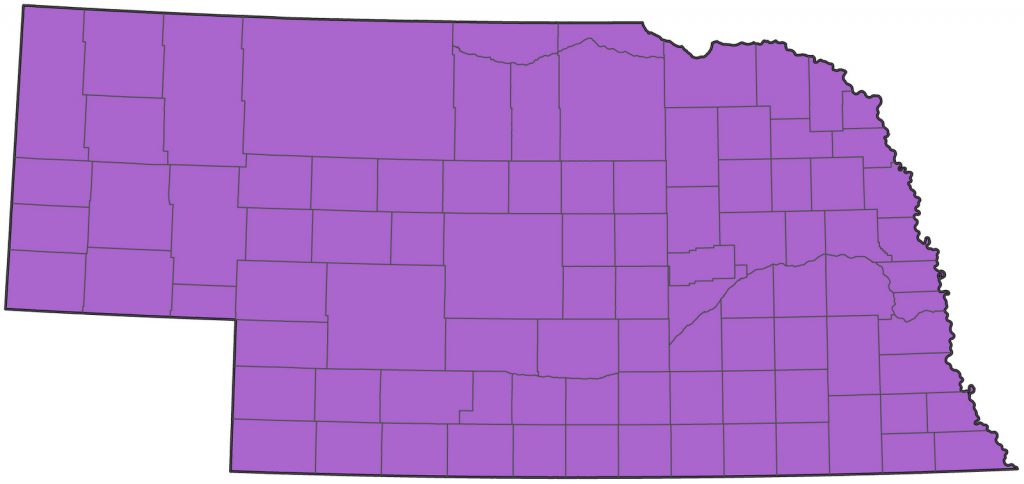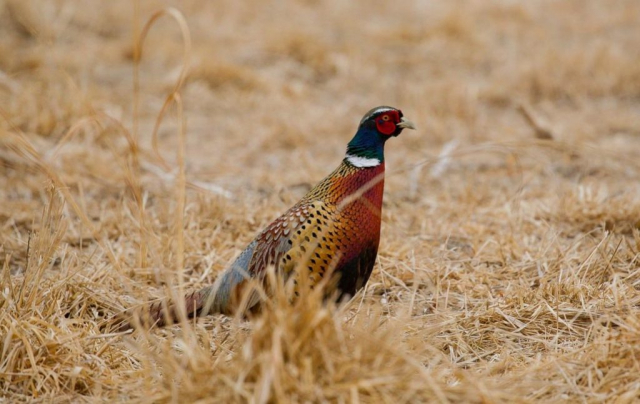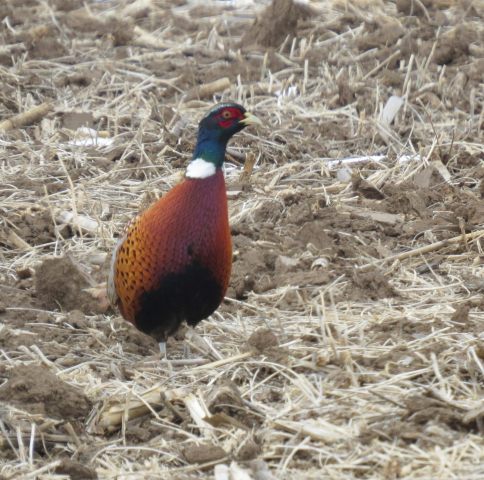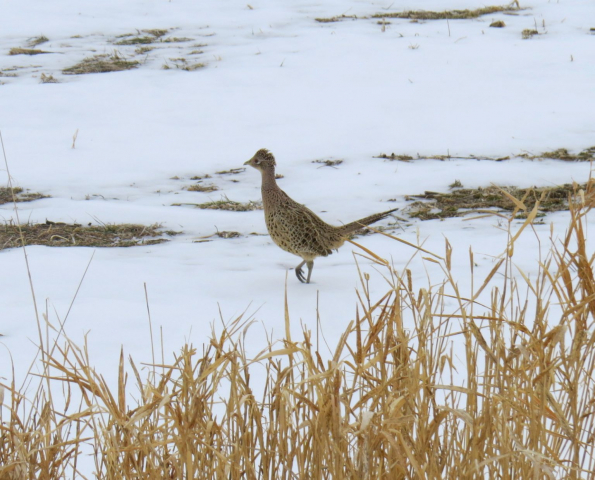Phasianus colchicus
Status: Introduced. Fairly common, locally common, regular resident statewide.

Documentation: Specimen: WSC 394, 17 Feb 1978 Boone Co.
Taxonomy: There are 30 subspecies generally recognized (AviList 2025, Giudice et al 2022).
North American birds are mostly from Asian populations, although derivatives of European birds have also been mixed into many North American releases, including those in Nebraska (AOU 1998, Vazquez-Miranda et al 2020). A mtDNA study of Nebraska and South Dakota wild and captive pheasants found that most wild birds belonged to a matrilineal line associated with torquatus, originating in Asia, whereas captive birds sampled were more evenly divided between torquatus and European colchicus, suggesting possible different abilities to adapt to wild conditions in Nebraska and South Dakota (Vazques-Miranda et al 2020).
AviList (2025) calls this species Common Pheasant.
Some authors have treated Asian and European birds as separate species, P. torquatus and P. colchicus respectively, but variability within the five groups of subspecies and interbreeding in areas of secondary contact suggests otherwise (Giudice et al 2022).
Resident: Swenk (1930) suggested that Nebraska’s first pheasants may have spread north naturally from Kansas following introductions there; during 1900-1904 pheasants had been shot at Table Rock, Pawnee, and Barneston. However, Lonnie Shafer (personal communication) documented several releases by private individuals and groups beginning in 1894; during 1894-1898 releases were made at least in Washington, Gage, Lancaster, and Dawes Cos. These releases predate by several years the putative “first introduction…by a private individual” near Ord, Valley Co in 1909 (Mathisen and Mathisen 1960). The State of Nebraska established a hatchery at Antelope Park, Lancaster Co in 1911 following an appropriation of $5000 by the legislature (Lonnie Shafer, personal communication). From 1912 through 1923 the state released some 3946 pheasants to counties around Nebraska (Lonnie Shafer, personal communication), at odds with Swenk’s statement (1930) that “No very large number of pheasants were ever brought into Nebraska, probably not over 500 pairs altogether.” By 1930, the Nebraska pheasant population was estimated at over one million (Swenk 1930), and over one million were harvested in 1958 (Mathisen and Mathisen 1960). Since then, repeated introductions and stockings around the state, including small-scale releases of captive-reared birds in localized areas have continued. These small-scale releases, often on Nebraska WMAs, are intended primarily to bolster numbers during the hunting season.
According to reports of hunters and NGPC records (and see above), high population densities were achieved by the late 1940s and early 1950s, particularly in the south and east. Since then, numbers have declined, apparently as a consequence of agricultural intensification that reduced habitats important for nesting, brood-rearing, and shelter (Taylor et al 1978), as well as declines in Nebraska grassland acres enrolled in the Federal Conservation Reserve Program (CRP). BBS Trend Analysis shows an annual decline of -1.78 (95% C.I. -2.78, -0.87) during the years 1966-2015 (Sauer et al 2017; see below).
Presently, highest densities occur in southwestern Nebraska, south central Nebraska along the Kansas border, and northwest of the Sandhills in Box Butte and Sheridan Counties (Hiller et al 2015). Recent examples of the high numbers in the southwest are from 20 X 2-minute stops in Hitchcock Co 17 Apr 2010 that had 893 and 659 roosters, and another there that had 1299 birds on 1 May 2012 (T.J. Walker, NGPC, personal communication). The 2-minute listening protocol is based on research showing roosters have a crow rate of 0.608 per 2 minutes (Luukonen 1997).
Lowest densities occur in intensely agricultural regions in eastern Nebraska. Densities are also relatively low in the Sandhills, which generally lack cover such as hedgerows, dense grasses, woodland borders, and brushy groves (Johnsgard 1979, Giudice et al 2022). Nesting has been reported in most counties across the state (Ducey 1988) and probably occurs in all. As with other upland game birds, densities vary from year to year and over a period of years in response to environmental conditions, especially weather extremes.
CRP is a federal program which pays landowners across the United States to take land out of row crop agricultural production. In Nebraska, most CRP land has been planted to grass and forbs, which has influenced overall pheasant numbers in Nebraska. The total acres in CRP in Nebraska have been variable since the program began in 1986, and have generally declined since 2007 (NGPC 2017, Nielson et al 2006). In Nebraska, pheasant numbers are not only closely related to the amount (Eric Zach, personal communication), but also the concentration of available CRP grassland (King and Savidge 1995). Hiller et al (2015) investigated variation in Nebraska pheasant populations based on a 1951-2007 series of mail carrier surveys; the results indicated that there was an annual decline of approximately 15% until 1986 that was followed, however, by a slower decline of about 5% after 1986. The authors suggest that the CRP program, which began in 1986, slowed the decline in pheasant numbers.
- Breeding Phenology:
Eggs: 11 Apr-22 Aug (Mollhoff 2022).
Dependent young: 2 Jun-2 Sep.
Pheasants are essentially sedentary. Highest CBC counts are from the east; high counts from various localities are 565 at DeSoto NWR, Washington Co in 1983-84, 510 at Norfolk, Madison Co in 1994-95, and in the west 36 at Scottsbluff, Scotts Bluff Co in 1981-82, 23 at Crawford, Sioux Co in 1978-79, and 22 at North Platte, Lincoln Co in 1981-82. Non-CBC counts were 350 on a Hayes Co farm 8 Dec 2007, 327 in the Boyer Chute NWR, Washington Co area 30 Jan 2004, and 250+ in the same general area 25 Jan 2003.
Images
Abbreviations
AOU: American Ornithologists’ Union
BBS: Breeding Bird Survey
CBC: Christmas Bird Count
CRP: Conservation Reserve Program
NGPC: Nebraska Game and Parks Commission
NWR: National Wildlife Refuge
WMA: Wildlife Management Area
WSC: Wayne State College
Acknowledgement
Jeffrey J. Lusk provided numerous helpful comments that improved this species account. Photograph (top) of a Ring-necked Pheasant in Lincoln Co, 6 Feb 2017, courtesy of NEBRASKALAND/Nebraska Game and Parks Commission.
We especially thank Lonnie Shafer for sharing his unpublished research about historical pheasant releases in Nebraska.
Literature Cited
American Ornithologists’ Union [AOU]. 1998. The AOU Check-list of North American birds, 7th ed. Allen Press, Lawrence, Kansas, USA
AviList Core Team, 2025. AviList: The Global Avian Checklist, v2025. https://doi.org/10.2173/avilist.v2025.
Ducey, J.E. 1988. Nebraska birds, breeding status and distribution. Simmons-Boardman Books, Omaha, Nebraska, USA.
Giudice, J.H., J.T. Ratti, and S.G. Mlodinow. 2022. Ring-necked Pheasant (Phasianus colchicus), version 1.1. In Birds of the World (N. D. Sly, Editor). Cornell Lab of Ornithology, Ithaca, NY, USA. https://doi.org/10.2173/bow.rinphe1.01.1.
Hiller, T.L., J.S. Taylor, J.J. Lusk, L.A, Powell, and A.J. Tyre. 2015. Evidence That the Conservation Reserve Program Slowed Population Declines of Pheasants on a Changing Landscape in Nebraska, USA. Wildlife Society Bulletin 39: 529-533.
Johnsgard, P.A. 1979. Birds of the Great Plains: breeding species and their distribution. University of Nebraska Press, Lincoln, Nebraska, USA.
King, J.W., and J.A. Savidge. 1995. Effects of the Conservation Reserve Program on Wildlife in Southeast Nebraska. Wildlife Society Bulletin 23: 377-385.
Luukkonen, H., H. Prince, and I.L. Mao. 1997. Evaluation of Pheasant Crowing Rates as a Population Index. Journal of Wildlife Management 61: 1338-1344.
Mathisen, J., and A. Mathisen. 1960. History and status of introduced game birds in Nebraska. NBR 28:19-22.
Mollhoff, W.J. 2022. Nest records of Nebraska birds. Nebraska Ornithologists’ Union Occasional Paper Number 9.
Nebraska Game and Parks Commission [NGPC]. 2017. CRP in Nebraska by the numbers, accessed 31 March 2018.
Nielson, R.M., L.L. McDonald, J. Sullivan, C. Burgess, D.S. Johnson, and S. Howlin. 2006. Estimating response of the ring-necked pheasant (Phasianus colchicus) to the Conservation Reserve Program. Technical report prepared for US Department of Agriculture Farm Service Agency, Contract Number 53-3151-5-8059, Western EcoSystems Technology, Inc., 2003 Central Avenue, Cheyenne, Wyoming USA.
Sauer, J.R., D.K. Niven, J.E. Hines, D.J. Ziolkowski, Jr, K.L. Pardieck, J.E. Fallon, and W.A. Link. 2017. The North American Breeding Bird Survey, Results and Analysis 1966 – 2015. Version 2.07. USGS Patuxent Wildlife Research Center, Laurel, Maryland, USA.
Swenk, M.H. 1930. The food habits of the ring-necked pheasant in central Nebraska. Research Bulletin: Bulletin of the Agricultural Experiment Station of Nebraska No. 50.
Taylor, M.W., C.W. Wolfe, and W.L. Baxter. 1978. Land-use change and ring-necked pheasants in Nebraska. Wildlife Society Bulletin: 6: 226-230.
Vazquez-Miranda, H., M.J. Olson, and R.M. Zink. 2020. Evolutionary Origin and Genetic Diversity of Ring‐necked Pheasants in the Upper Midwest United States. Wildlife Society Bulletin 44: 246–251. DOI: 10.1002/wsb.1095.
Recommended Citation
Silcock, W.R., and J.G. Jorgensen. 2025. Ring-necked Pheasant (Phasianus colchicus). In Birds of Nebraska — Online. www.BirdsofNebraska.org
Birds of Nebraska – Online
Updated 7 Jul 2025



